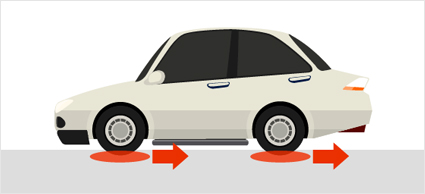Properly preparing yourself and your vehicle can give you a better driving experience and keep you safe when driving in wet and rainy conditions.

Preparing to drive in wet conditions
Before you head out, be sure to check on the condition of your vehicle and your tyres.

Tips for driving in wet conditions
When it’s time to head out, keep a few of these tips in mind.

Source: Goodyear
The four main functions and seven performance characteristics of tires.


To support a vehicles weight To transmit accelerating and braking force to the ground


To change/maintain direction To absorb shock from the road surface


Fuel efficiency Wear life


Dry grip Wet grip


Handling stability Ride comfort

Quietness
Sources: Bridgestone
So you’ve just bought a new set of tyres for your car and you’re ready to hit the road. Before you do that, here are a few things to keep in mind to make sure your new tyres last longer and also keep you and your loved ones safe on the road.


Drive smoothly
As simple as this sounds, the way you drive your car greatly affects how your tyres wear and how long they’ll last. Smoother gear changes, gentler braking, acceleration and cornering can all help to prevent unnecessary wear to your tyres.


 Be aware of where you drive
Be aware of where you drive
Another thing that you can do to help prolong the life of your new tyres is to pay attention to the road surface and your surroundings. Whether it’s potholes, uneven roads or even just not parking too close to a kerb, being careful when you drive not only keeps you safe but gives your tyres a longer lifespan too.
Keep your tyres properly inflated If your tyres are under-inflated, they create excess heat and this can lead to blowouts and make them more likely to puncture. Inversely, if your tyres are overinflated, blowouts can happen too due to overpressure and your treads will wear out a lot faster. That’s why making sure your tyres are properly inflated lets them last longer, and keeps you safer.
Get your wheels aligned
When your wheels are out of alignment, your tyre treads will wear out unevenly. This makes one part of the tyre weaker and more likely to get damaged. By getting your tyres aligned regularly, you can help make sure your treads wear evenly and last longer.
Check your tyres for tread wear
It’s inevitable for the rubber on your tyres to wear off the longer you drive. But what you can do to make sure that the treads wear evenly is to bring them in for check annually. This will not only let you take the necessary actions to prevent uneven tread wear, it also keeps you updated on the state of your tyres and how safe they are.
Source: Goodyear
If your brakes are trying to tell you something, you should pay attention. A properly operating brake system helps ensure safe vehicle control and operation and it should be checked immediately if you suspect any problems, says the non-profit Car Care Council.
“While an annual brake inspection is a good way to ensure brake safety, motorists should not ignore signs that their brakes need attention,” said Rich White, executive director, Car Care Council. “Knowing the key warning signs that your brakes may need maintenance will go a long way toward keeping you and others safe on the road.”
The Car Care Council reminds motorists to look for the following warning signs that their brakes need to be inspected:
Because brakes are a normal wear item on any vehicle, they will eventually need to be replaced. Factors that can affect brake wear include driving habits, operating conditions, vehicle type and the quality of the brake lining material. Be sure to avoid letting brakes get to the ‘metal-to-metal’ point as that can mean expensive rotor or drum replacement.
Source: Car Care Council
The first thing you should know is that a car battery’s lifespan is fixed and there’s nothing you can do to extend it beyond that. But, there are things drivers often do that cause the battery to die early. Learn how to care for your battery and be rewarded with a long battery life.
Shorts distance trips prevent your car’s battery from a full charge cycle. Over the long run, this will reduce the charge capacity of the battery and its lifespan. Instead, go for a long distance drive once a week during the weekend to give the battery a full charge it deserves.
Battery terminals corrode over time, but keeping them clean from buildup is a great way to extend the life of your car battery. Scrub the terminals with a toothbrush dipped in a baking soda and water mixture. Then, using a spray bottle with cold water, rinse the mixture off and follow up with a thorough drying with a clean cloth.
Turn off functions like the radio or air conditioner when your engine isn’t running to put less wear and tear on your battery power. Extended periods of idling also can wear a battery down. And not to forget, don’t charge your smartphone before starting your car’s engine.
A battery that’s not securely fastened could end up vibrating, potentially resulting in internal damage and short circuits. Have your battery terminal checked regularly, especially if you frequently drive on bumpy roads.
If your alternator is bad it will results in ineffective recharging of your battery and dramatically shorten your battery’s lifespan.
Source: Carput
Car tyre pressure is measured by calculating the amount of air that has been pumped into the inner lining of your tyre in pounds per square inch (PSI) or BAR pressure.
The manufacturer of your vehicle will specify the suitable pressure for your tyres, and it is your responsibility as the driver to make sure that the pressure is checked and corrected on a regular basis. We recommend doing this every two weeks to ensure optimum tyre pressure.

Under inflated tyres
Tyres can quickly become underinflated if you don’t check them regularly. Under inflated tyres will have uneven contact with the road and will exhibit excessive wear on the inside and outside edges of the tread if they are left underinflated for some time. Not only does low tyre pressure wear your tyres out more quickly but you may also experience increased rolling resistance with the road which means reduced fuel efficiency and increased CO2 emissions.
Over inflated tyres
Putting too much air in your tyres can be just as damaging and costly. Over inflated tyres will have a smaller contact patch – the part of the tyre that makes contact with the road – which can lead to a loss of traction and poorer braking distances. Overly high tyre pressure will also cause heavy and uneven wear across the central part of the tyre leading to shorter tyre lifespans than if it was correctly inflated.
Correct tyre pressures
It’s not always apparent that air is being lost from your tyres, but it generally escapes at the rate of up to two PSI of air every month. More air is usually lost during warm weather, so more regular checks are needed when temperatures rise.
You can find the recommended tyre pressure for your vehicle in your vehicle handbook or printed either in the sill of the driver’s door or on the inside of the fuel tank flap. Your vehicle manufacturer may suggest different tyre pressures for your front and rear tyres so make sure you aware of these guidelines.
Sources:KwikFit
Rotating your tyres periodically can help to prevent uneven wear and prolong the lifespan of your tyres.
When should you rotate your tyres? Generally speaking, it is recommended that you rotate the tyres on your vehicle once every six months, or 6,000 miles – whichever comes first.
To do so, each tyres need to be removed and refitted at a different position. This helps to ensure that each tyre wears evenly and lasts longer.
For each driving method, there is a correct way to rotate your tyres. You want to ensure that you rotate the tyres to the correct position for your vehicle.

The two front tyres stay on the same of the car and are transferred to the rear. However, the rear tyres move forward and switch sides.

The two rear tyres stay on the same side of the car and are transferred to the front. However, the front tyres move backwards and switch sides.

In this instance both sets of tyres swap sides and position. So the two front tyres move back and switch. At the same time the two rear tyres move forward and switch.
The above rules should not be followed if your tyres are ‘directional tyres’. The tread pattern on this variety tyre is designed specifically to work in a certain way in relation to its position on the vehicle – switching sides would be dangerous.

The tyres change position, but do not switch. The two front tyres move back and the two rear tyres move forward – they stay on the same side of the car as before.
Source: blackcircle.com